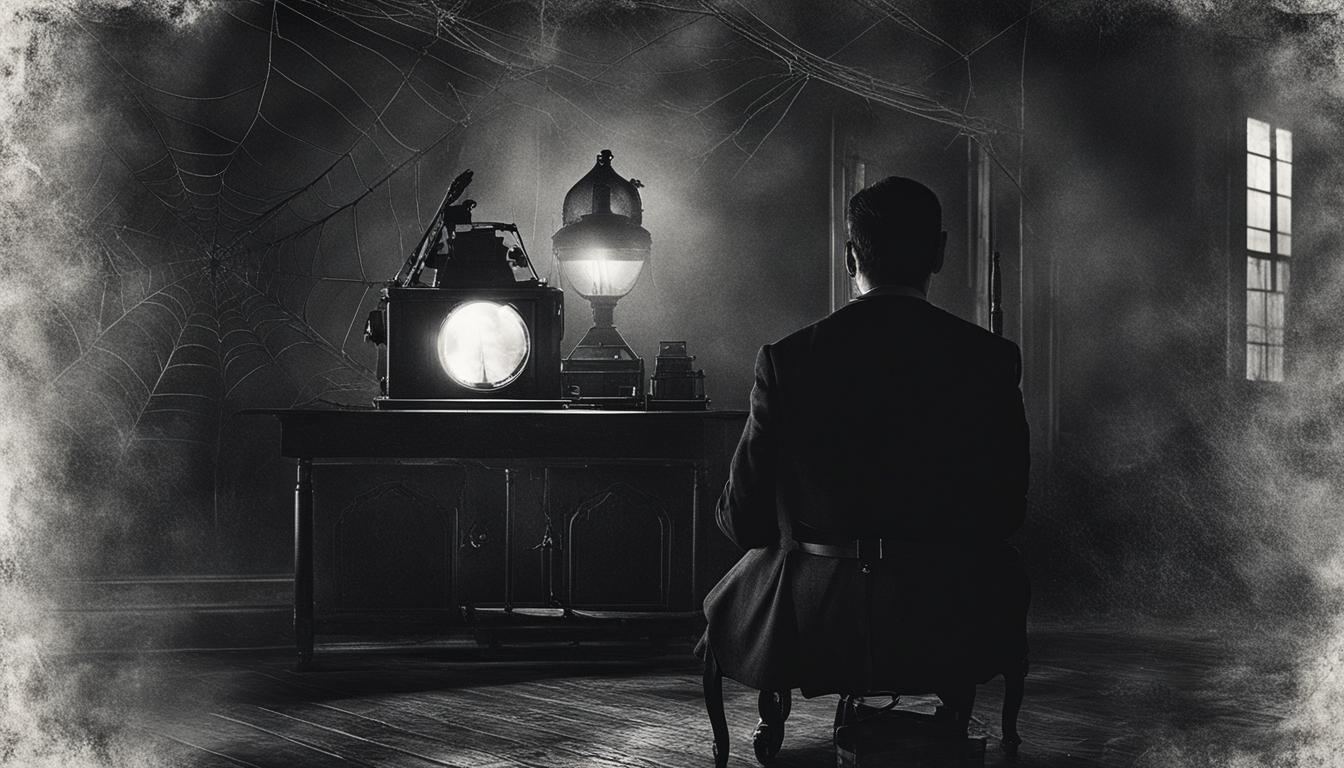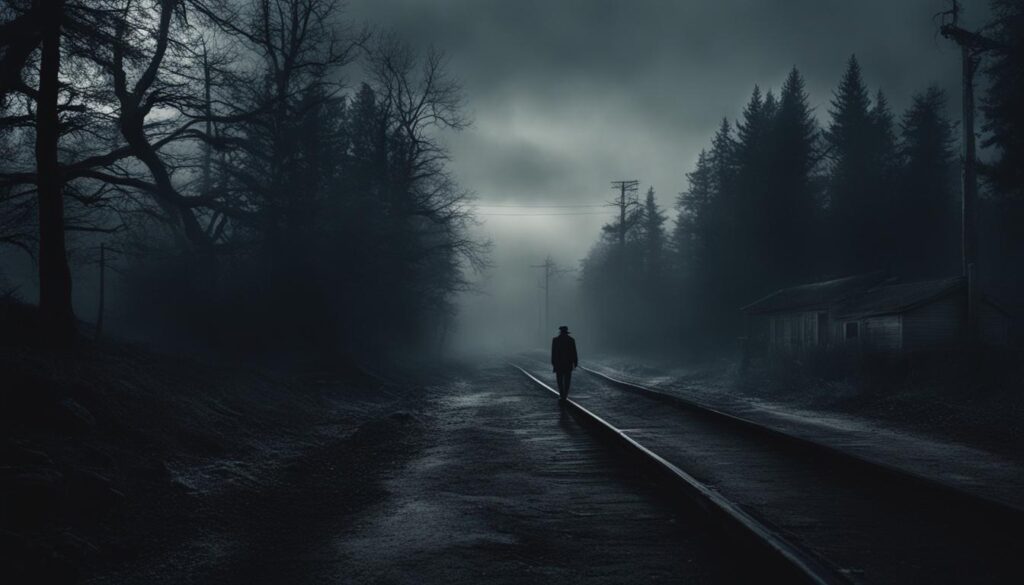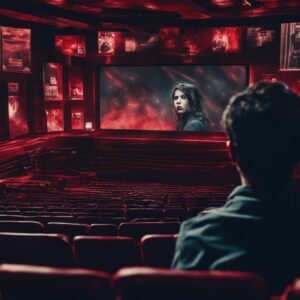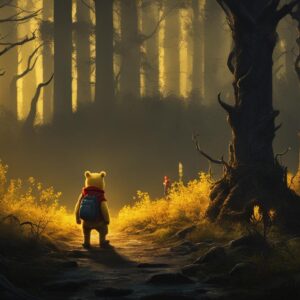I want to delve into a fascinating aspect of the genre that has been captivating audiences for decades – the horror movie silence requirement. It’s an essential element in creating suspense and tension, and silent horror movies have perfected the art of atmospheric storytelling with their eerie soundtracks and lack of dialogue.
Key Takeaways:
- The horror movie silence requirement adds to the suspense and fear in the genre.
- Silent horror movies have a rich history and continue to captivate audiences today.
- Atmospheric storytelling and creepy soundtracks are signature elements of silent horror films.
- Streaming platforms offer a wide selection of silent horror movies for enthusiasts to enjoy.
- The future of silent horror films holds exciting possibilities for innovative storytelling.
The Role of Silence in Horror Movies
Silence plays a crucial role in creating a sense of anticipation and fear in horror movies. By removing or minimizing dialogue and sound, filmmakers can heighten the suspense and allow viewers’ imaginations to run wild. The absence of noise draws attention to subtle sounds, like a creaking floorboard or a distant whisper, making them more impactful and eerie.
In horror movie genres, silence is often used tactically to create tension before a jump scare or a terrifying revelation. The sudden absence of sound can make the audience feel vulnerable and heighten their anticipation for what might happen next. This deliberate manipulation of silence and sound is an effective technique used by filmmakers to generate fear and unease.
The contrast between moments of silence and sudden bursts of sound can be compared to the calm before the storm, intensifying the impact on the audience. It’s this interplay between silence and sound that keeps viewers on the edge of their seats, never knowing when the next scare will hit.
Furthermore, the absence of a traditional soundtrack allows the audience to immerse themselves in the atmosphere of the film. Creepy visuals combined with silence can evoke a deep sense of dread and unease, as the viewers become more attuned to the smallest sounds and nuances in the environment. This heightened awareness and engagement with the film’s world intensify the overall horror experience.
Elements of Horror Movies
- Eerie silence
- Sudden bursts of sound
- Absence of music
The Psychological Impact of Silence
Silence taps into primal fears and engages the audience’s imagination. By relying on silence and minimizing auditory cues, horror films create a sense of vulnerability and helplessness. The absence of sound allows viewers to project their fears onto the screen, making the experience more personal and terrifying.
Silent Horror Movies Throughout History
Silent horror movies have been captivating audiences for decades with their atmospheric storytelling and chilling visuals. From the early days of cinema to the present, these films continue to leave a lasting impression on viewers. Let’s take a journey through the history of silent horror and explore some recommendations for must-watch films.
The Early Masters of Silent Horror
The silent horror genre gained popularity in the 1920s, with iconic films such as Nosferatu and The Cabinet of Dr. Caligari. Nosferatu, directed by F.W. Murnau, is a haunting adaptation of Bram Stoker’s Dracula, featuring the infamous vampire Count Orlok. The Cabinet of Dr. Caligari, directed by Robert Wiene, is a psychological horror film known for its expressionist style and twisted narrative.
| Film | Director | Year |
|---|---|---|
| Nosferatu | F.W. Murnau | 1922 |
| The Cabinet of Dr. Caligari | Robert Wiene | 1920 |
These films laid the foundation for the atmospheric and visually striking nature of silent horror. Their influence can still be felt in contemporary horror movies.
Modern Silent Horror Gems
While silent horror films had their heyday in the early 20th century, there have been recent offerings that pay homage to the genre while adding a fresh twist. The Artist, directed by Michel Hazanavicius, is a silent film set in Hollywood during the transition from silent movies to talkies. It won numerous awards, including the Academy Award for Best Picture. A Girl Walks Home Alone at Night, directed by Ana Lily Amirpour, is an Iranian vampire Western that combines elements of horror, romance, and dark humor.
| Film | Director | Year |
|---|---|---|
| The Artist | Michel Hazanavicius | 2011 |
| A Girl Walks Home Alone at Night | Ana Lily Amirpour | 2014 |
These modern silent horror films showcase the enduring appeal of the genre and the creative ways filmmakers continue to explore its potential.
Whether you’re a fan of classic silent horror or looking for something new and innovative, these recommendations offer a glimpse into the chilling world of atmospheric horror. Step into the shadows, embrace the silence, and prepare to be captivated by the power of silent horror films.
The Impact of Silent Horror on Modern Filmmaking
The influence of silent horror movies can be seen in modern filmmaking, with many contemporary horror films incorporating elements of silence to create suspenseful and atmospheric experiences. Filmmakers have recognized the power of silence in building tension and terror, harnessing its ability to captivate audiences and evoke a deeper emotional response.
The use of silence in films such as “A Quiet Place” and “It Follows” adds an extra layer of intensity, as the absence of sound amplifies the audience’s fear and forces them to rely on their own imaginations. This deliberate use of silence not only heightens the suspense but also allows viewers to connect more deeply with the characters, as they experience the same vulnerability and uncertainty.
By embracing the themes of horror movie silence, filmmakers are able to push boundaries and explore new ways of storytelling. They continue to find innovative approaches to create suspenseful horror films, while also paying homage to the silent horror movies that have come before. This blend of old and new techniques creates a unique cinematic experience that keeps audiences on the edge of their seats.
| Modern Horror Films | Key Themes |
|---|---|
| “A Quiet Place” | Silence as a means of survival |
| “It Follows” | Silence as a symbol of impending danger |
| “The Babadook” | Silence as a metaphor for repressed trauma |
Through the use of suspenseful silence, filmmakers are able to create an immersive experience that lingers in the minds of viewers long after the credits roll. Silent horror movies have left an indelible mark on modern filmmaking, shaping the way we approach and appreciate the horror genre. As technology and storytelling techniques continue to evolve, we can expect to see even more intriguing and chilling silent horror films in the future.
The Evolution of Silent Horror
“Silent horror films have fundamentally changed the way we perceive fear and suspense in movies. The absence of sound allows the audience’s imagination to fill in the gaps, making the experience more personal and terrifying.” – Film Critic
- Early silent horror films relied heavily on atmospheric visuals and expressive acting to convey fear and suspense.
- Sound effects and music were later incorporated into silent horror films, heightening the impact of key moments and enhancing the overall experience.
- Contemporary silent horror films push the boundaries of visual storytelling, using innovative techniques to create unsettling and unforgettable scenes.
The Evolution of Horror Movie Soundtracks
The role of soundtracks in horror movies cannot be underestimated. In silent horror films, where dialogue and sound effects are absent, soundtracks play a crucial role in setting the tone and atmosphere. Creepy soundtracks have the power to send chills down your spine and intensify the viewer’s emotional experience. From haunting melodies to dissonant sounds, these soundtracks enhance the storytelling and add another layer of unease to the movie.
Throughout the history of silent horror films, filmmakers have experimented with different types of soundtracks to enhance the horror and suspense. The use of eerie and evocative music has become a trademark of the genre. By carefully selecting the right sounds and melodies, filmmakers can manipulate the audience’s emotions and create an immersive experience.
Table:
| Silent Horror Film | Creepy Soundtrack |
|---|---|
| Nosferatu | A combination of eerie strings and organ music |
| The Cabinet of Dr. Caligari | Experimental and dissonant sounds |
| The Phantom of the Opera | Melancholic and haunting melodies |
These examples demonstrate the wide range of soundtracks used in silent horror films. Each film has its own unique approach to creating a creepy and unsettling atmosphere through music. These soundtracks contribute to the overall impact of the film, drawing viewers deeper into the world of horror.
The Power of Music in Silent Horror
“The music in silent horror films is like an unseen character in itself, guiding the audience’s emotions and heightening the suspense. It’s fascinating how a haunting melody or a dissonant sound can evoke such strong reactions and enhance the horror experience.” – Film Critic
Psychological Impact of Silence in Horror Films
The horror movie silence requirement goes beyond just creating suspense and fear – it has a profound psychological impact on viewers. By relying on silence and minimizing auditory cues, horror films tap into primal fears and engage the audience’s imagination. The absence of sound can create a sense of vulnerability and helplessness, amplifying the emotional response to the on-screen horrors.
When we watch a horror movie, our senses are heightened, and we become more attuned to even the slightest hint of danger. Silence in horror films acts as a trigger, signaling that something dreadful is about to happen. It puts us on edge, constantly anticipating what might lurk in the darkness. By stripping away the comfort of sound, silent horror movies intensify our fearful state, making the experience even more unnerving.
This deliberate use of silence in horror films also allows the viewers to fill in the gaps with their own imaginative horrors. Our minds start conjuring up the worst possible scenarios, building upon the eerie silence to create a personalized sense of terror. This engagement of the audience’s imagination makes the horror feel more personal and immersive.
Breaking the Silence: Psychological Tricks in Silent Horror Films
“Silent horror movies have the power to play with our minds. By manipulating our perception of sound, these films heighten our senses and create a deeper psychological impact. The lack of sound allows the audience to fill in the gaps with their own fears, making the horror more personal and terrifying.”
– Film critic, Emily Thompson
Furthermore, silent horror films often make use of visual cues and cinematography to enhance the psychological impact. Close-up shots, extreme angles, and clever editing techniques all contribute to the overall sense of unease and dread. Without relying on dialogue or sound, filmmakers have to employ visually striking techniques to convey the horror effectively.
In conclusion, the horror movie silence requirement is not just a stylistic choice – it’s a psychological tool that immerses viewers in a world of terror. By leveraging silence, filmmakers tap into our primal fears, engage our imaginations, and heighten our emotional response. Silent horror films continue to push the boundaries of psychological horror, captivating audiences with their atmospheric storytelling and innovative techniques.
Silence vs. Sound in Horror Movies
When it comes to horror movies, the use of silence and sound both play crucial roles in creating fear and tension. While silence is often associated with the genre, it’s important to recognize that sound can also be a powerful tool in evoking fear. In horror movie genres, the contrast between silence and sudden bursts of sound can be utilized to great effect, heightening the scare factor and keeping viewers on the edge of their seats.
Sound effects, chilling music, and dialogue all have the potential to enhance the suspense and provide a dynamic audio experience for the audience. A well-placed scream, an eerie whisper, or a sudden loud noise can elicit a visceral reaction and send shivers down the spine. These auditory cues, when used strategically, can heighten the overall sense of unease and make the horror movie experience more immersive.
However, silence in horror movies is equally effective in creating fear and tension. By removing or minimizing dialogue and sound, filmmakers can tap into primal fears and engage the audience’s imagination. The absence of sound can create a sense of vulnerability and helplessness, allowing viewers to project their worst fears onto the screen. It is the anticipation during moments of silence that intensifies the impact of subsequent scares, making them even more terrifying.
Ultimately, the balance between silence and sound is key to creating a captivating and immersive horror movie experience. Filmmakers carefully manipulate these elements to elicit specific emotional responses from the audience, whether it be a jump scare accompanied by a loud sound or a quiet moment that leaves viewers anxiously waiting for the next fright. It is this delicate dance between silence and sound that keeps horror movie genres thrilling and audiences coming back for more.
Table: A Comparison of Silence and Sound in Horror Movies
| Aspect | Silence | Sound |
|---|---|---|
| Emotional Impact | Suspenseful and eerie, engages the audience’s imagination | Intense and immediate, elicits visceral reactions |
| Fear Factor | Creates a sense of vulnerability and helplessness | Enhances the scare factor and keeps viewers on edge |
| Immersive Experience | Allows viewers to project their own fears onto the screen | Enhances the overall atmosphere and audiovisual experience |
| Anticipation | Builds tension and intensifies subsequent scares | Provides immediate jolts and surprises |
The Audience’s Reception of Silent Horror Films
When it comes to silent horror films, the audience’s reception can be as varied as the movies themselves. Some viewers appreciate the atmospheric storytelling and the ability to engage their imagination, finding a unique appeal in the absence of dialogue and sound. These individuals are drawn to the haunting visuals, the suspenseful storytelling, and the chilling atmosphere that silent horror films deliver.
On the other hand, there are those who may find silent horror movies challenging or less immersive without the spoken word and surrounding sound effects. These viewers may prefer the dynamic audio experience that comes with dialogue, sound effects, and chilling musical scores. For them, the absence of sound can make it difficult to fully connect with the story and characters.
It’s important to approach silent horror films with an open mind and an appreciation for their artistic qualities. These films offer a different cinematic experience, one that relies on visuals, subtle movements, and the power of suggestion to create fear and suspense. For fans of the genre and cinephiles seeking atmospheric horror movies, silent horror films can be a captivating and rewarding choice.
Top Silent Horror Film Recommendations:
- Nosferatu (1922) – A classic vampire tale that remains hauntingly effective to this day.
- The Cabinet of Dr. Caligari (1920) – A surreal masterpiece that introduced the world to German Expressionism.
- The Artist (2011) – A love letter to the silent movie era, blending romance and horror in a unique and captivating way.
- A Girl Walks Home Alone at Night (2014) – A stylish and atmospheric vampire film set in an Iranian ghost town.
These silent horror films showcase the power of silence in creating a sense of unease, fear, and suspense. They are a testament to the lasting impact and appeal of the genre, proving that sometimes, less is truly more when it comes to horror.
Silent Horror Films on Streaming Platforms
Streaming platforms like Netflix offer a treasure trove of silent horror films for enthusiasts to explore. These platforms provide convenient access to a wide selection of atmospheric and spine-chilling movies that utilize the horror movie silence requirement to create fear and suspense. Whether you’re a fan of classic horror or interested in discovering contemporary offerings, streaming platforms have something to satisfy your silent horror cravings.
Some highly recommended silent horror films available on streaming platforms include:
- Nosferatu: A classic vampire tale that set the standard for horror films and remains a masterpiece of silent cinema.
- The Phantom of the Opera: This iconic film showcases the horror lurking beneath the opera house, with a chilling performance by Lon Chaney as the disfigured Phantom.
- Haxan: A unique blend of documentary and horror, this Danish film delves into the history of witchcraft and the superstitions that fueled the witch trials.
With just a few clicks, viewers can immerse themselves in the eerie and atmospheric world of silent horror from the comfort of their homes. So grab your popcorn, turn off the lights, and prepare to be captivated by the power of silence in these chilling cinematic experiences.
Silent Horror Films Recommendations
| Film Title | Year | Director |
|---|---|---|
| Nosferatu | 1922 | F.W. Murnau |
| The Phantom of the Opera | 1925 | Rupert Julian |
| Haxan | 1922 | Benjamin Christensen |
The Future of Silent Horror Films
| Year | Movie Title | Director |
|---|---|---|
| 2020 | The Invisible Man | Leigh Whannell |
| 2018 | A Quiet Place | John Krasinski |
| 2014 | It Follows | David Robert Mitchell |
The future of silent horror films holds great potential for captivating audiences and pushing the boundaries of storytelling. As technology advances, filmmakers are finding innovative ways to create atmospheric horror movies without traditional dialogue and sound. With the rise of suspenseful horror films like “The Invisible Man” (2020) directed by Leigh Whannell, it is evident that the power of silence continues to evoke fear and suspense.
Another notable entry in contemporary silent horror is “A Quiet Place” (2018), directed by John Krasinski. This film explores a world where silence is essential for survival, and the absence of traditional sound amplifies the tension and terror experienced by the characters and viewers alike. It showcases the lasting impact of silent horror on modern filmmaking, captivating audiences with its suspenseful storytelling.
In 2014, “It Follows” directed by David Robert Mitchell garnered critical acclaim for its use of silence to create an unsettling and eerie atmosphere. This psychological horror film exemplifies the evolving nature of silent horror and the creative approaches that filmmakers are taking to engage audiences in new and terrifying ways.
As we embrace the future of silent horror, we can anticipate more atmospheric films that rely on visual storytelling, chilling soundtracks, and the power of silence to immerse viewers in a world of unease and fear. The genre’s ability to engage the audience’s imagination and evoke intense emotional responses ensures that silent horror films will continue to captivate and terrify audiences for years to come.
Conclusion
In conclusion, the horror movie silence requirement is a fundamental aspect of the genre that creates suspense, fear, and a unique cinematic experience. Silent horror movies have a long and captivating history, captivating audiences with their atmospheric storytelling and innovative use of sound (or lack thereof). The psychological impact of silence in horror films engages the audience’s imagination and heightens their emotional response to on-screen terrors.
Streaming platforms offer a convenient way to explore the world of silent horror, with a wide selection of classic and contemporary titles available. Whether you’re a fan of atmospheric horror movies or seeking recommendations for suspenseful horror films, streaming platforms like Netflix provide easy access to the chilling atmosphere of silent horror from the comfort of your own home.
As the genre evolves, filmmakers are constantly pushing the boundaries of silent horror to ensure its continued relevance and appeal. The future holds exciting possibilities for silent horror films as technology advances and storytelling techniques evolve. Viewers can look forward to innovative and chilling silent horror experiences in the years to come.
FAQ
What is the role of silence in horror movies?
Silence in horror movies is used to create suspense and fear by minimizing auditory cues and allowing the audience’s imagination to run wild.
How do silent horror movies utilize soundtracks?
Silent horror movies often rely on eerie and evocative soundtracks to set the tone and enhance the atmosphere of the film.
How does the absence of sound impact viewers in horror films?
The absence of sound in horror films can create a sense of vulnerability and helplessness, heightening the viewer’s emotional response to the on-screen horrors.
Can sound be used alongside silence in horror movies?
Yes, the contrast between silence and sudden bursts of sound can be utilized to great effect in horror movies to enhance fear and tension.
How do viewers typically perceive silent horror films?
Silent horror films have a unique appeal to fans of the genre and cinephiles seeking a different cinematic experience. However, some viewers may find it challenging or less immersive without dialogue and sound.
Where can I watch silent horror films?
Silent horror films are available to stream on platforms like Netflix, offering a wide selection of classic and contemporary titles.
What does the future hold for silent horror films?
As technology advances and storytelling techniques evolve, filmmakers are finding new ways to push the boundaries of silent horror, ensuring its continued relevance and appeal.







